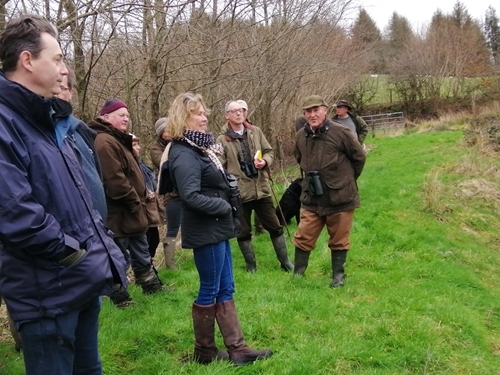
Whooper Swan, Little Egret, Stockdove, Siskin, Redpoll, Bullfinch, Buzzard and Red Kite were amongst a list of birds that were seen at Cruglas Farm, which hosted the first NFU sponsored GWCT Wales Big Farmland Bird Count near Tregaron, Ceredigion last Thursday (30th January). Local farmers were invited to a training day before the official count which runs for a week (7 – 16 February).
Owner of Cruglas, farmer and conservationist Terry Mills, is currently collaborating with neighbouring farmers and The Game & Wildlife Conservation Trust (GWCT) to develop a ‘Sustainable Management Scheme’ project near Cors Caron, Tregaron.
This scheme funded by the Welsh Government and the European Union is aimed at creating more wildlife corridors to boost biodiversity over a landscape scale.
Mr Mills has kept meticulous wildlife records over the past 25 years on his 720-acre beef and sheep farm which includes 210 rented acres from the adjoining Cors Caron Nature Reserve.
Over the past 25 years he has recorded 144 bird species of which 80 have actually bred on his ground, in addition to this list are nine species of bat and 26 species of butterfly.
Matt Goodall from GWCT Cymru presented to the group and stressed the potential to increase biodiversity on so many Welsh pasture-based farms like Cruglas.
“We can really help boost bird numbers by using what we call the ‘three legged stool’ approach of planting trees, hedges and cover crops, giving birds supplementary feeding from seed hoppers, particularly through the ‘hungry gap’ months of late winter and ensuring that nesting birds are protected using legal predator control”.
Research shows that if you remove one of these three elements the stool falls over and the project to enhance biodiversity fails
“Livestock such as Terry’s Welsh Black cattle on Cruglas are a key part of a farm’s ecosystem, poaching the ground they provide micro-habitats for insects which are a valuable source of food for many birds. Selective grazing by sheep and cattle are also very effective in breaking up and managing coarse vegetation, opening up habitat for insects and birds and a more diverse range of plant life”.
“There are a whole host of methods that can be adopted by farmers that will turn around farmland bird declines and greatly benefit wildlife whilst fitting in with current farming systems. This doesn’t have to involve major changes to farming, but will bring about significant improvement in biodiversity across Wales”.
How to take part: Download a count sheet from www.bfbc.org.uk and count your birds! On a day between February 7 and 16, spend about 30 minutes recording the species and number of birds seen in one particular area, aiming for approximately 5 acres. Once completed, submit results at www.bfbc.org.uk.

Get your GWCT Big Farmland Bird Count Badge for £5.00
Limited edition - only 250 produced
Show your support for the Game & Wildlife Conservation Trust's Big Farmland Bird Count, taking place in February.
View Badge >
or
Buy Badge Now >
100% Secure. All Credit & Debit cards, PayPal, Apple Pay and Google Pay accepted.
